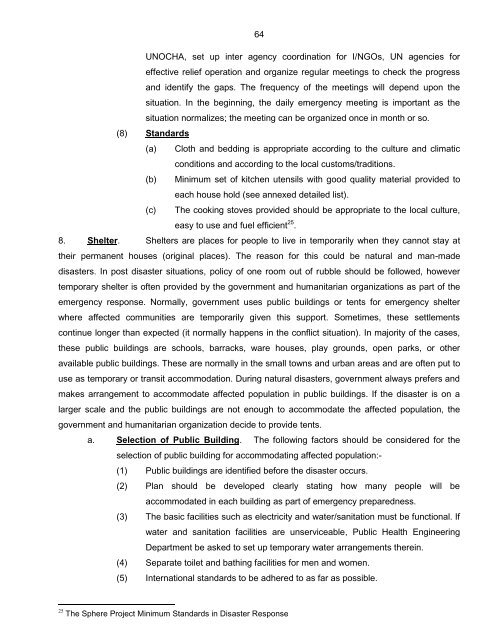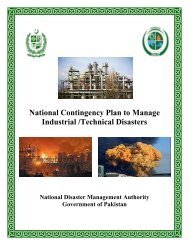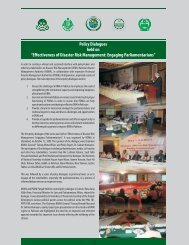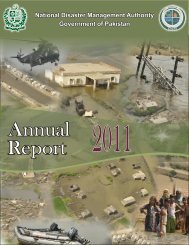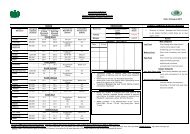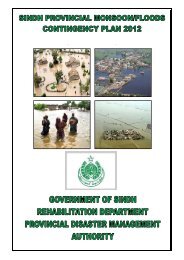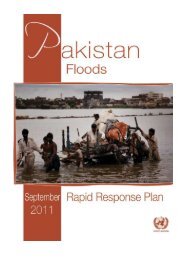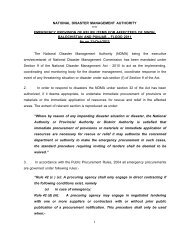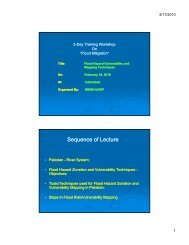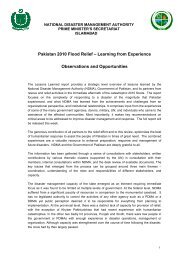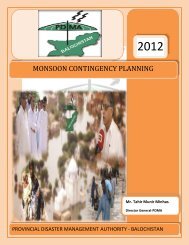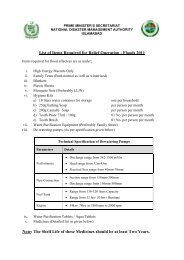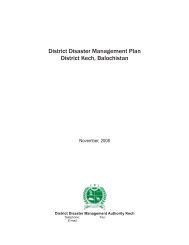National Disaster Response Plan (NDRP) March 2010 - NDMA
National Disaster Response Plan (NDRP) March 2010 - NDMA
National Disaster Response Plan (NDRP) March 2010 - NDMA
You also want an ePaper? Increase the reach of your titles
YUMPU automatically turns print PDFs into web optimized ePapers that Google loves.
64<br />
UNOCHA, set up inter agency coordination for I/NGOs, UN agencies for<br />
effective relief operation and organize regular meetings to check the progress<br />
and identify the gaps. The frequency of the meetings will depend upon the<br />
situation. In the beginning, the daily emergency meeting is important as the<br />
situation normalizes; the meeting can be organized once in month or so.<br />
(8) Standards<br />
(a) Cloth and bedding is appropriate according to the culture and climatic<br />
conditions and according to the local customs/traditions.<br />
(b) Minimum set of kitchen utensils with good quality material provided to<br />
each house hold (see annexed detailed list).<br />
(c) The cooking stoves provided should be appropriate to the local culture,<br />
easy to use and fuel efficient 25 .<br />
8. Shelter. Shelters are places for people to live in temporarily when they cannot stay at<br />
their permanent houses (original places). The reason for this could be natural and man-made<br />
disasters. In post disaster situations, policy of one room out of rubble should be followed, however<br />
temporary shelter is often provided by the government and humanitarian organizations as part of the<br />
emergency response. Normally, government uses public buildings or tents for emergency shelter<br />
where affected communities are temporarily given this support. Sometimes, these settlements<br />
continue longer than expected (it normally happens in the conflict situation). In majority of the cases,<br />
these public buildings are schools, barracks, ware houses, play grounds, open parks, or other<br />
available public buildings. These are normally in the small towns and urban areas and are often put to<br />
use as temporary or transit accommodation. During natural disasters, government always prefers and<br />
makes arrangement to accommodate affected population in public buildings. If the disaster is on a<br />
larger scale and the public buildings are not enough to accommodate the affected population, the<br />
government and humanitarian organization decide to provide tents.<br />
a. Selection of Public Building. The following factors should be considered for the<br />
selection of public building for accommodating affected population:-<br />
(1) Public buildings are identified before the disaster occurs.<br />
(2) <strong>Plan</strong> should be developed clearly stating how many people will be<br />
accommodated in each building as part of emergency preparedness.<br />
(3) The basic facilities such as electricity and water/sanitation must be functional. If<br />
water and sanitation facilities are unserviceable, Public Health Engineering<br />
Department be asked to set up temporary water arrangements therein.<br />
(4) Separate toilet and bathing facilities for men and women.<br />
(5) International standards to be adhered to as far as possible.<br />
25 The Sphere Project Minimum Standards in <strong>Disaster</strong> <strong>Response</strong>


